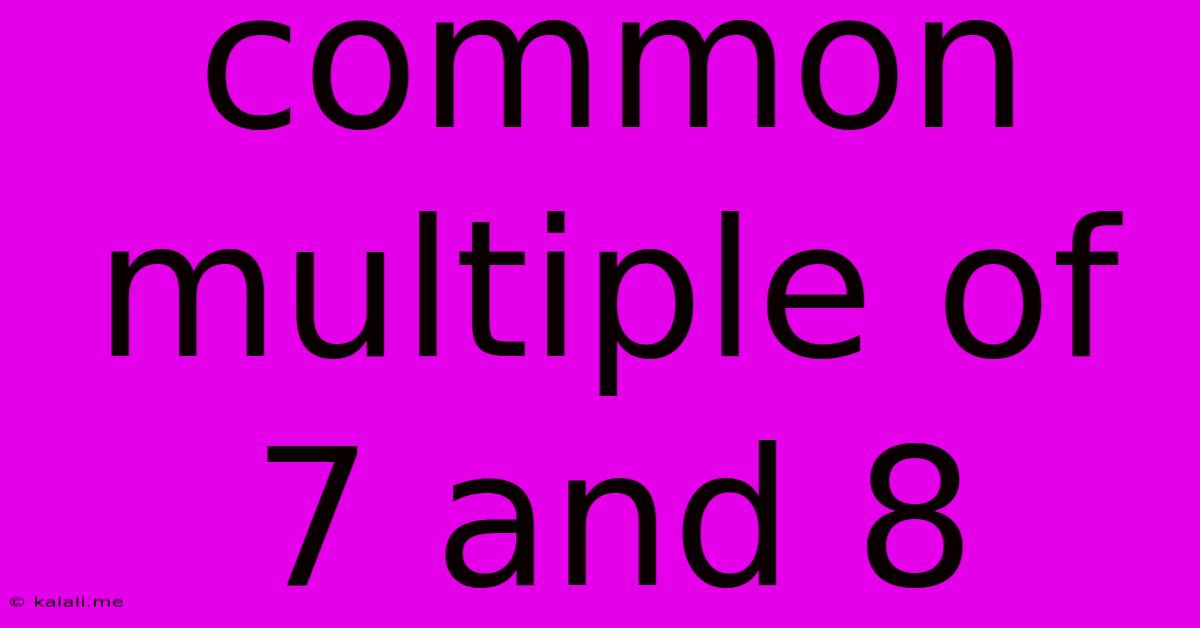Common Multiple Of 7 And 8
Kalali
May 09, 2025 · 3 min read

Table of Contents
Finding the Least Common Multiple (LCM) of 7 and 8: A Step-by-Step Guide
Finding the least common multiple (LCM) of two numbers is a fundamental concept in mathematics, crucial for various applications from simplifying fractions to solving complex problems in algebra and beyond. This article will guide you through the process of determining the LCM of 7 and 8, explaining the methods involved and providing a clear understanding of the underlying principles. Understanding LCMs is essential for anyone studying mathematics, and this guide provides a comprehensive explanation suitable for all levels.
What is a Least Common Multiple (LCM)?
The least common multiple (LCM) of two or more integers is the smallest positive integer that is divisible by all the integers. In simpler terms, it's the smallest number that both (or all) of your original numbers can divide into evenly. This is different from the greatest common divisor (GCD), which is the largest number that divides both numbers evenly.
Methods for Finding the LCM of 7 and 8
There are several ways to calculate the LCM of 7 and 8. Let's explore the two most common methods:
1. Listing Multiples Method
This method involves listing the multiples of each number until you find the smallest multiple that is common to both.
- Multiples of 7: 7, 14, 21, 28, 35, 42, 49, 56, 63, 70, 77, 84...
- Multiples of 8: 8, 16, 24, 32, 40, 48, 56, 64, 72, 80, 88, 96...
By comparing the lists, we can see that the smallest multiple common to both 7 and 8 is 56. Therefore, the LCM(7, 8) = 56. This method works well for smaller numbers but becomes less efficient with larger numbers.
2. Prime Factorization Method
This method is more efficient for larger numbers and involves finding the prime factorization of each number.
- Prime factorization of 7: 7 (7 is a prime number)
- Prime factorization of 8: 2 x 2 x 2 = 2³
To find the LCM using prime factorization:
- Identify all the prime factors: In this case, we have 2 and 7.
- Take the highest power of each prime factor: The highest power of 2 is 2³ = 8, and the highest power of 7 is 7¹ = 7.
- Multiply the highest powers together: 2³ x 7 = 8 x 7 = 56
Therefore, the LCM(7, 8) = 56 using the prime factorization method. This method is generally preferred for its efficiency, especially when dealing with larger numbers or a greater number of integers.
Applications of LCM
Understanding LCM has practical applications in various areas, including:
- Fraction Addition and Subtraction: Finding a common denominator when adding or subtracting fractions.
- Scheduling Problems: Determining when events will coincide, such as the overlapping of bus schedules or repeating cycles.
- Cyclic Processes: Analyzing repetitive patterns or cycles in various systems.
Conclusion
Determining the least common multiple is a valuable skill with broad applications in mathematics and beyond. Both the listing multiples and prime factorization methods provide accurate results, with prime factorization generally being more efficient for larger numbers. Understanding these methods empowers you to solve problems involving LCMs with confidence and efficiency. Remember to practice applying these techniques to various number combinations to solidify your understanding.
Latest Posts
Latest Posts
-
How Much Protein In 8 Oz Of Chicken
Jul 04, 2025
-
R C Cola And A Moon Pie
Jul 04, 2025
-
If I Was 18 What Year Would I Be Born
Jul 04, 2025
-
One And Three Hundred Twenty Four Thousandths
Jul 04, 2025
-
How Much Is 2 Pounds Of Cream Cheese
Jul 04, 2025
Related Post
Thank you for visiting our website which covers about Common Multiple Of 7 And 8 . We hope the information provided has been useful to you. Feel free to contact us if you have any questions or need further assistance. See you next time and don't miss to bookmark.